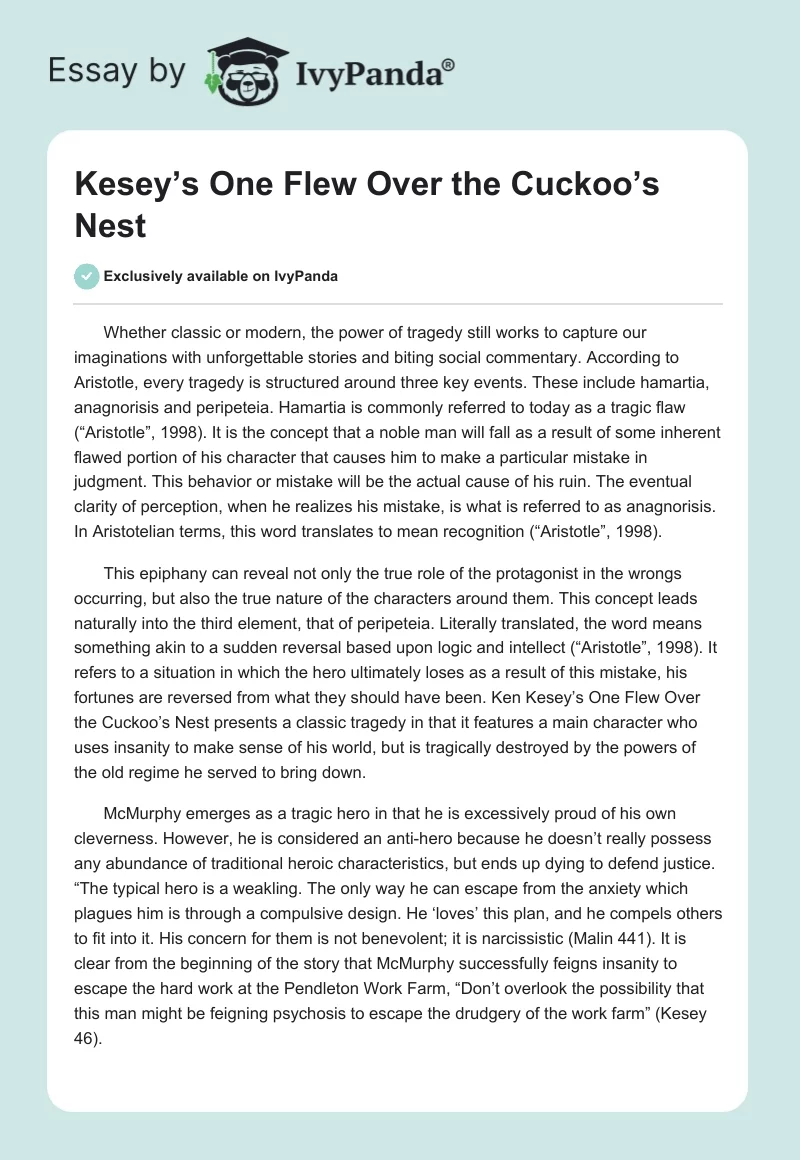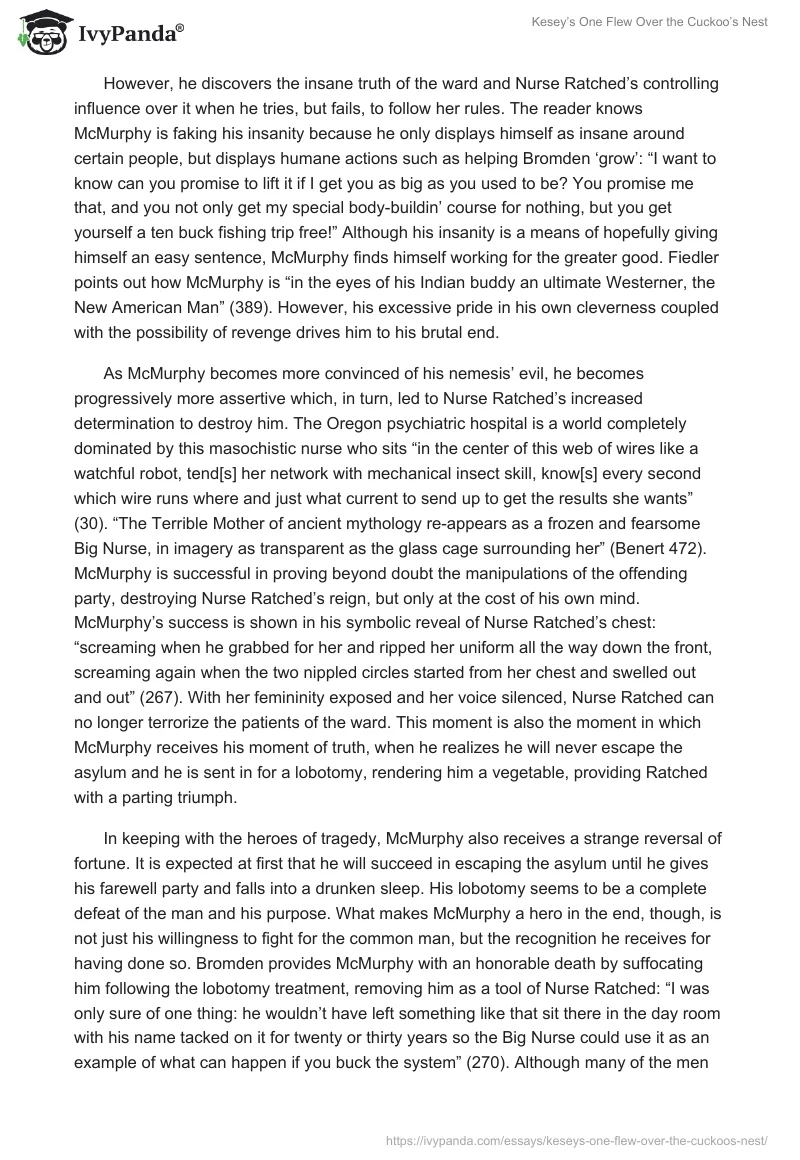Whether classic or modern, the power of tragedy still works to capture our imaginations with unforgettable stories and biting social commentary. According to Aristotle, every tragedy is structured around three key events. These include hamartia, anagnorisis and peripeteia. Hamartia is commonly referred to today as a tragic flaw (“Aristotle”, 1998). It is the concept that a noble man will fall as a result of some inherent flawed portion of his character that causes him to make a particular mistake in judgment. This behavior or mistake will be the actual cause of his ruin. The eventual clarity of perception, when he realizes his mistake, is what is referred to as anagnorisis. In Aristotelian terms, this word translates to mean recognition (“Aristotle”, 1998).
This epiphany can reveal not only the true role of the protagonist in the wrongs occurring, but also the true nature of the characters around them. This concept leads naturally into the third element, that of peripeteia. Literally translated, the word means something akin to a sudden reversal based upon logic and intellect (“Aristotle”, 1998). It refers to a situation in which the hero ultimately loses as a result of this mistake, his fortunes are reversed from what they should have been. Ken Kesey’s One Flew Over the Cuckoo’s Nest presents a classic tragedy in that it features a main character who uses insanity to make sense of his world, but is tragically destroyed by the powers of the old regime he served to bring down.
McMurphy emerges as a tragic hero in that he is excessively proud of his own cleverness. However, he is considered an anti-hero because he doesn’t really possess any abundance of traditional heroic characteristics, but ends up dying to defend justice. “The typical hero is a weakling. The only way he can escape from the anxiety which plagues him is through a compulsive design. He ‘loves’ this plan, and he compels others to fit into it. His concern for them is not benevolent; it is narcissistic (Malin 441). It is clear from the beginning of the story that McMurphy successfully feigns insanity to escape the hard work at the Pendleton Work Farm, “Don’t overlook the possibility that this man might be feigning psychosis to escape the drudgery of the work farm” (Kesey 46).
However, he discovers the insane truth of the ward and Nurse Ratched’s controlling influence over it when he tries, but fails, to follow her rules. The reader knows McMurphy is faking his insanity because he only displays himself as insane around certain people, but displays humane actions such as helping Bromden ‘grow’: “I want to know can you promise to lift it if I get you as big as you used to be? You promise me that, and you not only get my special body-buildin’ course for nothing, but you get yourself a ten buck fishing trip free!” Although his insanity is a means of hopefully giving himself an easy sentence, McMurphy finds himself working for the greater good. Fiedler points out how McMurphy is “in the eyes of his Indian buddy an ultimate Westerner, the New American Man” (389). However, his excessive pride in his own cleverness coupled with the possibility of revenge drives him to his brutal end.
As McMurphy becomes more convinced of his nemesis’ evil, he becomes progressively more assertive which, in turn, led to Nurse Ratched’s increased determination to destroy him. The Oregon psychiatric hospital is a world completely dominated by this masochistic nurse who sits “in the center of this web of wires like a watchful robot, tend[s] her network with mechanical insect skill, know[s] every second which wire runs where and just what current to send up to get the results she wants” (30). “The Terrible Mother of ancient mythology re-appears as a frozen and fearsome Big Nurse, in imagery as transparent as the glass cage surrounding her” (Benert 472). McMurphy is successful in proving beyond doubt the manipulations of the offending party, destroying Nurse Ratched’s reign, but only at the cost of his own mind. McMurphy’s success is shown in his symbolic reveal of Nurse Ratched’s chest: “screaming when he grabbed for her and ripped her uniform all the way down the front, screaming again when the two nippled circles started from her chest and swelled out and out” (267). With her femininity exposed and her voice silenced, Nurse Ratched can no longer terrorize the patients of the ward. This moment is also the moment in which McMurphy receives his moment of truth, when he realizes he will never escape the asylum and he is sent in for a lobotomy, rendering him a vegetable, providing Ratched with a parting triumph.
In keeping with the heroes of tragedy, McMurphy also receives a strange reversal of fortune. It is expected at first that he will succeed in escaping the asylum until he gives his farewell party and falls into a drunken sleep. His lobotomy seems to be a complete defeat of the man and his purpose. What makes McMurphy a hero in the end, though, is not just his willingness to fight for the common man, but the recognition he receives for having done so. Bromden provides McMurphy with an honorable death by suffocating him following the lobotomy treatment, removing him as a tool of Nurse Ratched: “I was only sure of one thing: he wouldn’t have left something like that sit there in the day room with his name tacked on it for twenty or thirty years so the Big Nurse could use it as an example of what can happen if you buck the system” (270). Although many of the men who might have remembered McMurphy have either transferred out of the ward or are now dead, such as Billy Bibbitt, Bromden still remembers McMurphy and recognizes the positive effect he had for everyone there. “This hero is too much of an individual, too powerful, actually too successful for that. Though he does not escape, his ally, the Columbia Indian Chief Broom does, and in him the natural man ultimately triumphs” (Barsness 434). Those who truly needed help transferred to facilities where they might actually get help while Nurse Ratched was rendered ineffective in the permanent loss of her voice, unable to assert her dominance into the future.
One Flew Over the Cuckoo’s Nest illuminates for the reader the honor to be found in tragedy, appealing deeply to the senses. The character of McMurphy shows us that good sometimes disguises itself as a rebellious villain, that heroes can be found within even the most imperfect or unheroic figure. McMurphy had a great deal of energy for trouble, but when he was brought into the environment of the psychiatric ward, complete with its high level of manipulation and oppression, that energy suddenly shifted from being one of destruction and chaos to one of progress and change. In doing so, he managed to demonstrate the connections we all have to each other. “The seeds of the madness of Kesey’s characters are in each one of us, sublimated, dormant, but waiting disconcertingly close to the surface” (Waldmeir 420). McMurphy merely needed the right setting to put his energies to moral purpose. The case of McMurphy as a tragic hero is made as he first demonstrates he has excessive pride in his own cleverness as he is first able to con the system into giving him a ‘soft’ sentence in the hospital instead of the prison and then is able to manipulate his way around Nurse Ratched’s strict authoritarian rules. The irony of the story exists in the fact that while McMurphy is able to prove himself honorable at the end in his defense of Billy and his attempt to stand up for the others, he is not able to enjoy the victory because he was himself destroyed by the villain he had brought down.
Works Cited
“Aristotle.” Critica Links. The University of Hawaii, (1998). Web.
Barsness, John A. “Ken Kesey: The Hero in Modern Dress.”
Benert, Annette. “The Forces of Fear: Kesey’s Anatomy of Insanity.”
Fiedler, Leslie A. “The Higher Sentimentality.”
Kesey, Ken. One Flew Over the Cuckoo’s Nest. New York: Signet, 1962.
Malin, Irving. “Ken Kesey: One Flew Over the Cuckoo’s Nest.”
Waldmeir, Joseph J. “Two Novelists of the Absurd: Heller and Kesey.”


 3.50
3.50
